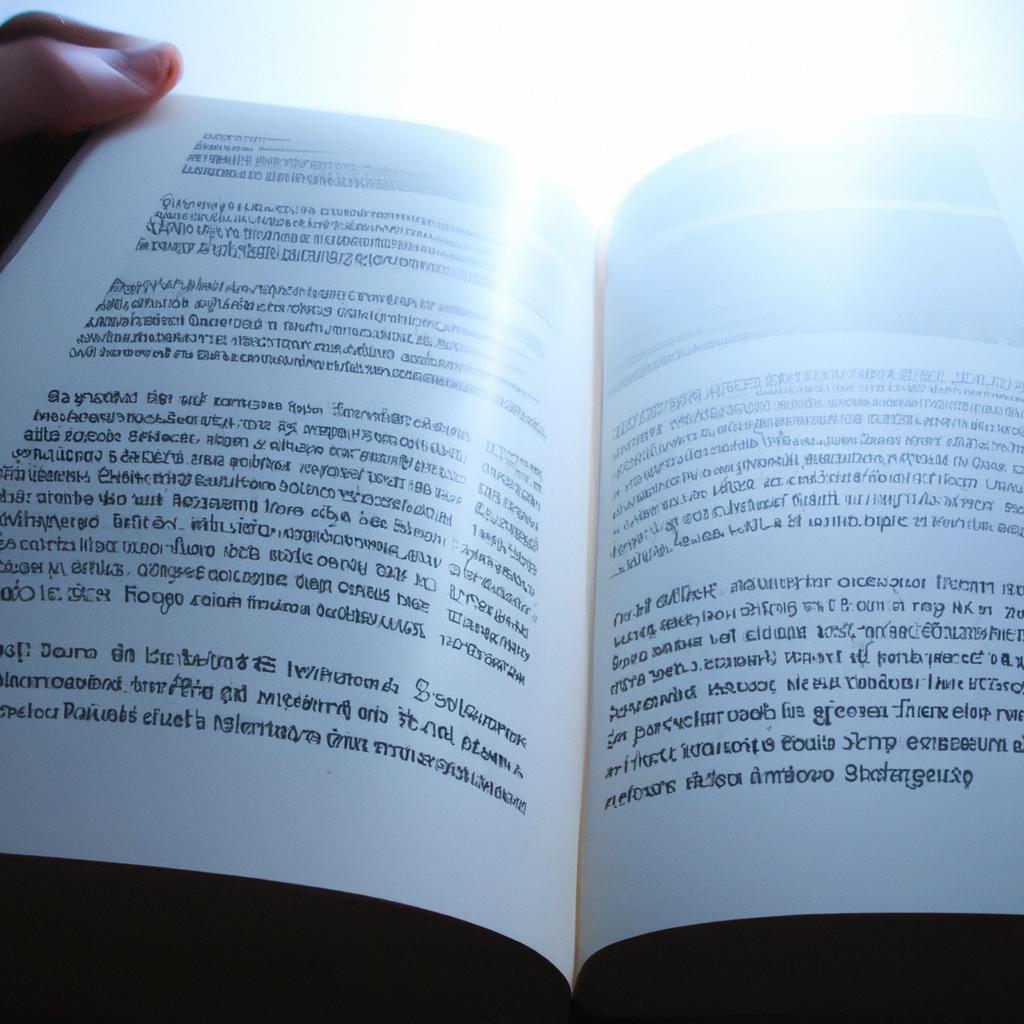The Mind-Body Problem: Metaphysical Perspectives

The mind-body problem has been a subject of intense philosophical debate for centuries, as it grapples with the fundamental question of how mental states and physical processes are related. This metaphysical conundrum poses intriguing challenges to our understanding of consciousness, identity, and the nature of reality itself. To illustrate this complex issue, let us consider a hypothetical scenario: Imagine an individual named Alex who experiences chronic pain in their lower back. From a purely physical perspective, one might argue that the sensation arises from nerve impulses transmitting signals from the affected area to the brain. However, when examining Alex’s subjective experience of pain, questions may arise regarding whether there is more to this phenomenon than merely physiological processes.
From various metaphysical perspectives, philosophers have attempted to address the mind-body problem by exploring different theories on the relationship between mind and body. Dualism posits that there exist two distinct substances – mind and matter – which interact but remain separate entities. René Descartes famously proposed this view through his concept of Cartesian dualism, suggesting that while bodily functions can be explained scientifically, conscious awareness stems from an immaterial soul or mind. On the other hand, materialism asserts that everything can ultimately be reduced to physical matter and its properties; thus, mental phenomena are nothing more than complex physical processes occurring in the brain. This perspective denies the existence of a separate immaterial mind and argues that consciousness is simply a byproduct of neural activity.
Another viewpoint is known as idealism, which posits that reality is ultimately mental or subjective in nature. According to this view, the physical world is dependent on consciousness and exists only within our minds. In other words, mental states are primary, and physical objects are secondary manifestations of those mental experiences.
There are also various forms of monism that attempt to reconcile the mind-body relationship by proposing different ways in which mental and physical phenomena can be unified. For example, property dualism suggests that while there may be only one substance (usually physical), it possesses both mental and physical properties. This allows for an integrated understanding where mental states arise from specific configurations or arrangements of physical matter.
Ultimately, the mind-body problem remains unresolved, with no consensus among philosophers and scientists regarding its solution. However, ongoing research in neuroscience, cognitive science, and philosophy of mind continues to shed light on this intricate issue, offering new insights into the nature of consciousness and its relationship to the physical world.
Dualism: The belief that the mind and body are two distinct entities.
Dualism is a metaphysical perspective that posits the existence of two distinct entities: the mind and the body. According to this view, the mind and body are separate and independent, with different properties and characteristics. This philosophical position has been debated for centuries, raising important questions about the nature of consciousness and its relationship to physical reality.
To illustrate the concept of dualism, let us consider an example. Imagine a person experiencing intense pain due to a physical injury. From a dualistic standpoint, this individual’s subjective experience of pain is considered separate from the underlying physiological processes occurring in their body. While medical professionals may identify specific nerve pathways or chemical reactions associated with pain, dualists argue that these objective observations cannot fully capture or explain the subjective experience itself.
There are several key points to consider when exploring dualism:
- Dualists believe that mental states (such as thoughts, emotions, and perceptions) are fundamentally different from physical states (such as brain activity or bodily sensations). They posit that mental events possess qualities like qualia – subjective experiences that cannot be reduced to mere physical processes.
- Proponents of dualism often cite examples such as near-death experiences or out-of-body experiences as evidence for the separation between mind and body. These phenomena suggest that consciousness can exist independently of the physical body.
- Critics argue against dualism by pointing out challenges in explaining how an immaterial mind could interact with a material body. Questions arise regarding causal interactions between these two realms without violating fundamental principles of physics.
- The debates surrounding dualism extend beyond philosophy into other disciplines such as psychology, neuroscience, and cognitive science. Researchers continue to explore various theories attempting to bridge gaps between subjective experiences and objective measurements.
| Dualism: Key Points |
|---|
| Mind vs Body |
| Qualia |
| Interaction |
| Interdisciplinary |
In summary, dualism presents a metaphysical perspective that asserts the existence of distinct entities: the mind and body. By examining examples and considering various arguments, proponents aim to demonstrate the fundamental differences between mental states and physical processes. However, critics raise questions about how these two realms interact, challenging the plausibility of this view.
Transitioning into the subsequent section on materialism, it is essential to explore an alternative philosophical position regarding the mind-body problem – materialism – which proposes that the mind is a product of physical processes in the brain.
Materialism: The view that the mind is a product of physical processes in the brain.
Dualism posits that the mind and body are two distinct entities. However, another philosophical perspective on the mind-body problem is materialism, which argues that the mind is a product of physical processes in the brain. This section will explore materialism as an alternative view to dualism.
To illustrate this perspective, let us consider the case of John, a middle-aged man who suffered a severe head injury in a car accident. Before the accident, John was known for his sharp intellect and quick wit. Afterward, however, he experienced significant cognitive impairments such as memory loss and difficulties with decision-making. According to materialism, these changes can be explained by physical damage to specific regions of John’s brain responsible for cognition and higher-order thinking.
Materialists argue their position using several key points:
-
Reductionism: Materialists believe that mental phenomena can ultimately be reduced to physical explanations. They assert that complex thoughts, emotions, and consciousness itself can all be understood through the study of neuronal activity and neural networks.
-
Empirical Evidence: Materialists rely heavily on empirical evidence from fields such as neuroscience and psychology to support their claims. By studying how different brain structures and processes correlate with various mental states and behaviors, they aim to establish a causal relationship between physical processes in the brain and mental experiences.
-
Occam’s Razor: Materialism aligns with Occam’s razor principle, suggesting that simpler explanations are often preferable to more complex ones. From this standpoint, attributing mental phenomena solely to physical processes within the brain eliminates the need for postulating additional non-physical entities or forces.
-
Unity of Science: Materialists advocate for a unified scientific approach where all phenomena can eventually be explained by naturalistic principles without invoking supernatural or metaphysical elements.
| Claims | Explanation |
|---|---|
| Mental phenomena have neurophysiological correlates | The experience of pain corresponds to specific patterns of electrical activity in certain brain regions. |
| Consciousness arises from complex interactions between neurons | Different patterns of neural firing and synchronization give rise to different states of consciousness, such as wakefulness or sleep. |
| Mental disorders can be understood in terms of brain abnormalities | Conditions like depression or schizophrenia can often be linked to specific structural or functional anomalies in the brain. |
| Altering brain activity through interventions can affect mental experiences | Techniques like deep brain stimulation have been shown to alleviate symptoms of conditions like Parkinson’s disease by modulating neuronal activity. |
In summary, materialism offers an alternative perspective on the mind-body problem by positing that the mind is a result of physical processes occurring within the brain. By emphasizing empirical evidence, reductionism, Occam’s razor, and the unity of science, materialists argue for a comprehensive understanding of mental phenomena without relying on separate non-physical entities.
Transitioning into the subsequent section about idealism: The notion that the mind is fundamental and reality is ultimately mental, we delve further into metaphysical perspectives on the mind-body problem.
Idealism: The notion that the mind is fundamental and reality is ultimately mental.
Materialism posits that the mind is a byproduct of physical processes occurring within the brain. However, another philosophical perspective on the mind-body problem is idealism, which asserts that the mind is fundamental and reality ultimately consists of mental entities. This section will explore the concept of idealism in relation to the mind-body problem.
To illustrate how idealism views the relationship between the mind and body, consider a hypothetical scenario where an individual experiences pain after stubbing their toe. From a materialistic standpoint, this sensation would be attributed solely to neural activity in the brain. In contrast, an idealist would argue that the experience of pain is not merely a result of physical processes but rather an intrinsic aspect of consciousness itself.
There are several key points to consider when examining idealism as it pertains to the mind-body problem:
- Primacy of Consciousness: Idealists believe that consciousness takes precedence over matter and shapes our perception of reality.
- Non-Physical Nature: According to idealism, consciousness cannot be reduced to or explained solely by physical processes.
- Epistemological Implications: Idealism suggests that knowledge about external objects relies heavily on subjective experiences and introspection.
- Ontological Framework: An idealistic view implies that reality fundamentally consists of mental entities or ideas rather than independent physical substances.
The following table illustrates some contrasting features between materialism and idealism regarding their perspectives on the mind-body problem:
| Materialism | Idealism |
|---|---|
| Mind arises from physical processes in the brain | Mind is fundamental and shapes reality |
| Emphasizes reductionist explanations for mental phenomena | Rejects reductionist approaches to understanding consciousness |
| Objective observation and empirical data play a crucial role | Subjective experiences form a significant basis for knowledge |
| Physical substances are primary constituents of reality | Mental entities are foundational elements |
In summary, while materialism attributes conscious experiences to purely physical causes, idealism posits that the mind is a fundamental aspect of reality. This perspective emphasizes the primacy of consciousness and challenges reductionist explanations for mental phenomena.
Transitioning to the subsequent section, we will now delve into neutral monism: the position that asserts the mind and body are two aspects of a single substance.
Neutral Monism: The position that the mind and body are two aspects of a single substance.
From the perspective of idealism, which posits that the mind is fundamental and reality is ultimately mental, we turn our attention to another philosophical stance known as neutral monism. Neutral monism proposes that the mind and body are two aspects of a single substance. To further explore this viewpoint, let us consider an example: imagine a person experiencing pain after stubbing their toe on a table leg. According to neutral monism, this painful sensation arises from the interaction between both physical processes in the body and mental states within the mind.
In examining neutral monism more closely, several key points emerge:
- The mind and body are not separate entities but rather interconnected facets of one unified substance.
- Mental events cannot be reduced solely to physical events or vice versa; they exist alongside each other without being reducible to either category alone.
- This perspective challenges traditional dualistic views by asserting that neither matter nor consciousness is primary over the other.
- Neutral monism offers an alternative approach to understanding how mental phenomena arise from physical processes while acknowledging their inherent interdependence.
To illustrate these points visually, consider the following table:
| Aspects | Mind | Body |
|---|---|---|
| Nature | Consciousness | Physicality |
| Properties | Subjective | Objective |
| Accessibility | Introspective | Empirical |
| Causality | Volitional | Mechanical |
This table highlights some distinguishing features between the mind and body according to neutral monism. It emphasizes that while there are differences between them in terms of nature, properties, accessibility, and causality, they are fundamentally intertwined within a singular framework.
As we delve into epiphenomenalism – which suggests that the mind is merely a byproduct of physical processes without any causal influence – it becomes clear how different perspectives offer unique insights into the complex relationship between the mind and body. Transitioning into the next section, we explore epiphenomenalism’s intriguing implications for understanding consciousness and its role in shaping our experiences.
Epiphenomenalism: The idea that the mind is a byproduct of physical processes and has no causal influence will be explored in the following section.
Epiphenomenalism: The idea that the mind is a byproduct of physical processes and has no causal influence.
Neutral Monism posits that the mind and body are two aspects of a single substance. However, another perspective on the mind-body problem is Epiphenomenalism, which asserts that the mind is merely a byproduct of physical processes and lacks any causal influence. This section will explore Epiphenomenalism as an alternative viewpoint to Neutral Monism.
To better understand Epiphenomenalism, let us consider an example: Imagine a person named John who experiences pain when he touches a hot stove. From an Epiphenomenalist standpoint, John’s experience of pain is not causally related to his hand touching the stove; rather, it is solely a consequence of underlying physical events occurring in his nervous system. According to this view, John’s feeling of pain has no impact on his decision-making or subsequent actions.
Epiphenomenalism raises several important implications worth considering:
- Lack of agency: If mental states have no causal efficacy, then our conscious experiences become passive spectators to our physical actions.
- Illusionary nature of consciousness: The belief that our thoughts and feelings play no active role challenges our intuitive understanding of consciousness and its purpose.
- Ethical considerations: If consciousness has no influence over behavior, questions regarding moral responsibility and accountability arise.
- Implications for psychology: Understanding how mental states interact with physical processes becomes critical in fields such as psychiatry and psychotherapy.
| Implications of Epiphenomenalism |
|---|
| Passive observers |
| Questions morality |
In conclusion, while Neutral Monism proposes that the mind and body are inseparable aspects of one substance, Epiphenomenalism presents an intriguing counterargument. By suggesting that mental phenomena are mere epiphenomena—secondary effects without causal power—we face profound philosophical and practical ramifications. Next, we shall delve into Panpsychism, a belief that consciousness is an inherent property of all matter.
[Transition to next section: Panpsychism asserts…]
Panpsychism: The belief that consciousness is a fundamental property of all matter.
Transitioning from the idea of epiphenomenalism, which posits that the mind is merely a byproduct of physical processes without any causal influence, we now turn our attention to another metaphysical perspective known as emergentism. This view suggests that mental states emerge from complex physical systems and cannot be reduced solely to physical properties.
To illustrate this concept, let us consider the example of consciousness arising in a human brain. According to emergentism, consciousness emerges when certain neuronal networks reach a level of complexity and organization that allows for self-awareness and subjective experience. Just as water molecules coming together give rise to the emergent property of wetness, so too do neural activities combine and interact to generate consciousness.
In exploring this perspective further, it is crucial to understand some key characteristics associated with emergentism:
- Non-reductive nature: Emergentists argue against reducing mental phenomena solely to physical components or mechanisms.
- Levels of organization: Mental states are seen as arising at higher levels of organizational complexity within a system.
- Novel properties: Emergence results in the emergence of novel properties not present at lower levels.
- Causal powers: Mental states possess causal powers while being dependent on underlying physical processes.
To visualize these ideas more clearly, we can examine them through a table:
| Characteristics | Description |
|---|---|
| Non-reductive nature | Rejects reductionist explanations that attempt to explain all mental phenomena purely physically. |
| Levels of organization | Views mental states emerging at higher levels within complex systems. |
| Novel properties | Emergence leads to new properties appearing at higher levels that were absent in lower ones. |
| Causal powers | Mental states have their own causal efficacy but depend on underlying physical processes. |
The notion of emergentism sheds light on how the mind can manifest as a result of intricate physical systems. By acknowledging that mental states are not reducible to their constituent parts, emergentism invites us to explore the complex interplay between physical processes and conscious experiences.
In summary, emergentism provides an alternative perspective to epiphenomenalism by proposing that the mind is an outcome of complex physical systems. Through its non-reductive nature, recognition of different levels of organization, emergence of novel properties, and acknowledgment of causal powers, emergentism enriches our understanding of the intricate relationship between mind and matter. This viewpoint encourages further exploration into how consciousness arises from physical complexity and offers a promising avenue for future research in philosophy of mind.






